
|
Astronomy Picture Of the Day (APOD)
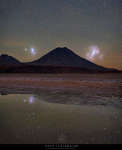 Magellanic Mountain
Magellanic Mountain
28.04.2018
Flanked by satellite galaxies of the Milky Way a volcanic peak rises from this rugged horizon. The southern night skyscape looks toward the south over Laguna Lejia and the altiplano of the Antofagasta Region of northern Chile.
 Gaia's Milky Way
Gaia's Milky Way
27.04.2018
This grand allsky view of our Milky Way and nearby galaxies is not a photograph. It's a map based on individual measurements for nearly 1.7 billion stars. The astronomically rich data set used...
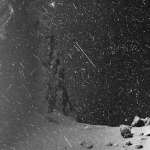 The Snows of Churyumov Gerasimenko
The Snows of Churyumov Gerasimenko
26.04.2018
You couldn't really be caught in this blizzard while standing by a cliff on Churyumov-Gerasimenko, also known as comet 67P. Orbiting the comet in June of 2016 the Rosetta spacecraft's narrow angle...
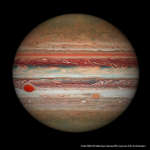 Hubbles Jupiter and the Shrinking Great Red Spot
Hubbles Jupiter and the Shrinking Great Red Spot
25.04.2018
What will become of Jupiter's Great Red Spot? Gas giant Jupiter is the solar system's largest world with about 320 times the mass of planet Earth. Jupiter is home to one of the largest and longest lasting storm systems known, the Great Red Spot (GRS), visible to the left.
 Play Saturns Rings Like a Harp
Play Saturns Rings Like a Harp
24.04.2018
Sure, you've seen Saturn's rings -- but have you ever heard them? Well then please take this opportunity to play Saturn's rings like a harp. In the featured sonification, increasing brighter regions of Saturn's central B-ring play as increasingly higher pitched notes.
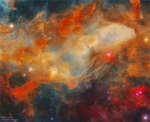 The Blue Horsehead Nebula in Infrared
The Blue Horsehead Nebula in Infrared
23.04.2018
The Blue Horsehead Nebula looks quite different in infrared light. In visible light, the reflecting dust of the nebula appears blue and shaped like a horse's head. In infrared light, however, a complex labyrinth of filaments, caverns, and cocoons of glowing dust and gas emerges, making it hard to even identify the equine icon.
 Meteor Over Crater Lake
Meteor Over Crater Lake
22.04.2018
Did you see it? One of the more common questions during a meteor shower occurs because the time it takes for a meteor to flash is typically less than the time it takes for a head to turn.
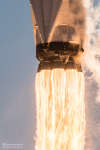 TESS Launch Close Up
TESS Launch Close Up
21.04.2018
NASA's Transiting Exoplanet Survey Satellite (TESS) began its search for planets orbiting other stars by leaving planet Earth on April 18. The exoplanet hunter rode to orbit on top of a Falcon 9 rocket.
 Moon in the Hyades
Moon in the Hyades
20.04.2018
Have you seen the Moon lately? On April 18, its waxing sunlit crescent moved through planet Earth's night across a background of stars in the Hyades. Anchored by bright star Aldebaran, the nearby, V-shaped star cluster and complete lunar orb appear in this telephoto image.
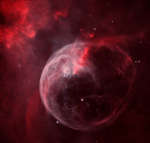 NGC 7635: The Bubble Nebula
NGC 7635: The Bubble Nebula
19.04.2018
Blown by the wind from a massive star, this interstellar apparition has a surprisingly familiar shape. Cataloged as NGC 7635, it is also known simply as The Bubble Nebula. Although it looks delicate, the 7 light-year diameter bubble offers evidence of violent processes at work.
|
January February March April May June July August September October November December |
|||||||||||||||||||||||||||||||||||||||||||||||||